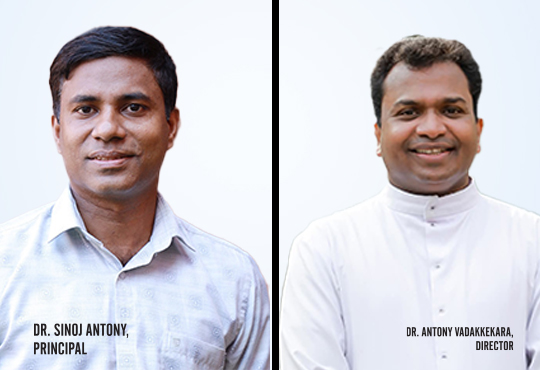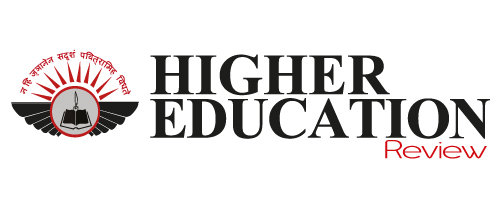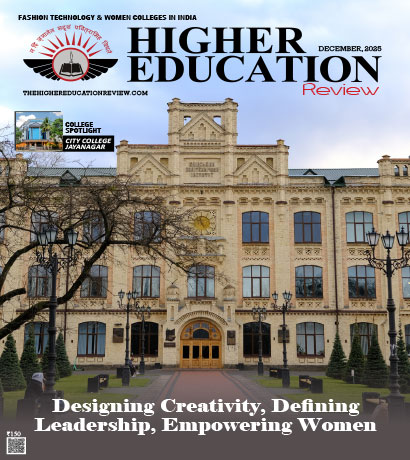Career Opportunities in Multi-Camera Live Broadcasting
 Antony Vadakkekara, Director, and Dr. Sinoj Antony, Principal, Divine Institute of Media Sciences, in an interaction with Higher Education Review, share their perspectives on the importance of hands-on training in Multi-camera Live Production for students in media. They described how new digital platforms, such as YouTube Live and OTT services, are transforming career pathways. Also, they emphasized the importance of industry collaborations, real-world simulation, and the use of technology like AR/VR to prepare students for high-pressure, high-risk broadcast situations.
Antony Vadakkekara, Director, and Dr. Sinoj Antony, Principal, Divine Institute of Media Sciences, in an interaction with Higher Education Review, share their perspectives on the importance of hands-on training in Multi-camera Live Production for students in media. They described how new digital platforms, such as YouTube Live and OTT services, are transforming career pathways. Also, they emphasized the importance of industry collaborations, real-world simulation, and the use of technology like AR/VR to prepare students for high-pressure, high-risk broadcast situations.
What specific skills - technical or creative should media and communication programs emphasize to help students build careers in multi-camera broadcasting?
A media program should focus on technical proficiency and creative decision-making. Technical skills such as camera operation, vision mixing, live switching, audio balancing, and lighting are significant components of a media program. Creative skills such as shot composition, editing in real time, storytelling, and planning for a production are also equally important. Competence in software, streaming protocols, and multiple platform distribution is crucial to get jobs in today's media environment.
A media program should reflect the importance of teamwork, time management, and effective communication under pressure. While modern facilities and advanced tools, including AI technologies, are readily available, the key to professional success lies in proper orientation and training.
How has the evolution of digital broadcasting platforms such as YouTube Live and OTT channels influenced the career landscape for students specializing in multi-camera live production?
The emergence of platforms such as YouTube Live, Facebook Live, and OTT services has vastly diversified career options for students interested in live production. Careers today are no longer limited to traditional television studios. Careers, such as content creators, event managers, influencers, and e-sports broadcasters, increasingly require multi-camera production skills. Students who are trained using scalable multi-camera skills can adjust to these career developments and can work on many platforms and formats.
The media landscape continues to evolve rapidly, driven by algorithms that influence content visibility and engagement. For instance, while Instagram once prioritized short-form videos, it now supports longer videos. Students today are highly observant of such trends, and our program actively supports them in understanding and responding to these ongoing changes in the digital environment.
In what ways can internships or industry collaborations enhance career readiness for students interested in technical roles such as camera control, switching, and live stream engineering in multi-camera setups?
Internships and connections with industry provide experience with real-time broadcast processes, resources, and workforce. These opportunities offer practical experience with advanced tools such as CCUs, broadcaster switchers, tally systems, and encoding software. A partnership with television studios, sports broadcasters, and OTT platforms allows learners to shadow professional entrepreneurs’ portfolios. These experiences enhance confidence, adaptability, and job readiness while helping students understand the evolving nature of production roles and build wider industry networks for future employment.
In the digital era, collaborations are crucial, especially in social media platforms. These collaborations significantly increase visibility and reach. Collaborations, whether via internship or co-branded content, can exponentially increase audience engagement and provide students with practical experience in the competitive media landscape.
How important is it for media and journalism students to gain multi-camera live production experience if they aim to enter high-pressure environments like live newsrooms or sports coverage?
Live news and sports coverage occur under intense time constraints where small technical issues or delays can have severe consequences that impact credibility. Experience in Multi-camera production trains students to think and act quickly, collaborate effectively, and ensure seamless broadcast continuity, even under pressure.
A solid understanding of live studio roles, effective communication, and emergency backup procedures is crucial for success in this high-stakes environment. Early exposure helps students handle the stress and speed of professional environments with accuracy and confidence, and ultimately, students can be equipped to respond in challenging situations while achieving high performance, regardless of the unexpected conditions.
What challenges do students face when transitioning from academic setups to high-budget, multi-camera professional environments, and how can educators address these through course design?
When students move into professional settings, they often face significant challenges, including industry scale, pressure, and a lack of familiarity with equipment. Many academic labs use a limited or basic version of the professional equipment, which can create skill gaps. To bridge this gap, educators can provide advanced simulation scenarios, expert-led master classes, and certification-based training.
In addition, programs should expose students to role rotation, technical troubleshooting, and preparing technical documents to build comprehensive skill sets. Integrating real-world production scenarios into the curriculum is essential for ensuring a smoother transition into professional roles. We actively support students in managing high-pressure situations and familiarize them with the latest industry-standard equipment and software.
How can academic training bridge the gap between theoretical knowledge and hands-on broadcast production experience?
Academic training should effectively combine classroom instruction with live studio experiences, simulations, mock events, and multi-camera shoots. The curriculum must include practical laboratory sessions with switching consoles, live streaming software, and end-to-end production workflows. Student projects should reflect real broadcast formats, such as news bulletins, talk shows, or conceptual programs, which allow them to apply theoretical knowledge in areas such as shot sequencing, timing, and lighting. Collaborations with media houses, guest lectures, and live event production opportunities further enrich the learning experience. Ultimately, experiential learning is crucial to converting theoretical knowledge into broadcast competence.
As immersive technologies like AR/VR begin integrating with live broadcasting, how should media curricula evolve to include these advancements and expand students’ career opportunities?
Augmented Reality (AR) and Virtual Reality (VR) are transforming the traditional media landscape, including news dissemination, communication systems, and multi-camera productions. These immersive tools create opportunities to increase audience engagement and also provide an effective way to convey complicated information and real-world experiences.
In education, AR and VR enable learners to connect with more complex content with a more interactive, visually-enhanced experience. By using these technologies in the learning setting, students are generally more flexible towards technology, as well as being able to manage stressful situations or resolve conflicts.

